
|
|

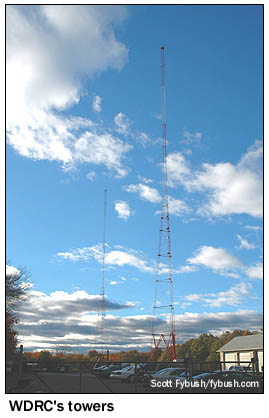 June 1, 2007
June 1, 2007
WDRC 1360/102.9, Hartford, CT
In previous installments of Tower Site of the Week, we've visited the oldest AM transmitter site in the Hartford market, the majestic WTIC 1080 site in Avon.
This week, we're pleased to present a look inside the market's second-oldest AM site, the facility at 869 Blue Hills Avenue in Bloomfield that's been home to WDRC, in one form or another, since December 5, 1930. That's when Franklin Doolittle moved his station, already eight years old, from New Haven up to Hartford, with studios in the Corning Building and 500 enormous watts of power on 1330.
Ed Brouder's wonderful WDRCOBG.com site has chronicled the station's history far better than I ever could, especially in his page of photos of the Blue Hills Avenue site, but here's a rough summary of the key points as far as this building goes:
The core of the building dates back to 1934, when it replaced an earlier building 40 feet away. Very little of the 1934 building is still visible amidst the additions and renovations that have taken place over the years, especially a 1954 expansion that moved the studios here from 750 Main Street in downtown Hartford. By then, WDRC had moved from 1330 to 1360, and had (in 1940) built its current two-tower directional array, running 5,000 watts full-time, directional at night.
In 1967, the studios returned to 750 Main Street, and in 1977, they came back to Blue Hills Avenue, at which point the current front of the building was added on, providing new office space (though, oddly enough, no windows!)
When we visited in the fall of 2006, after the Connecticut Broadcasters Association convention, the building had just recently been expanded again, this time at the rear, creating a new and spacious area for sales and programming offices, at the expense of some parking lot.
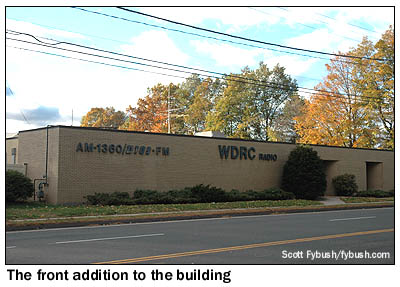
|
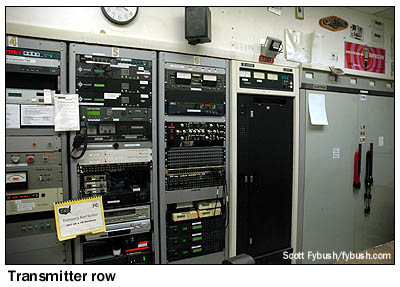
|
When we pull up in the parking lot next to the building on this sunny October afternoon, chief engineer Scott Baron (along with our friendly tower-hunting colleague Mike Fitzpatrick of NECRAT.com) is waiting out by the side of the building to show us around, starting with the generator by the side of the building and the new side entrance facing the parking lot. From there, a left turn goes back to the new sales addition, and a right turn goes into the heavily-renovated 1934 building, where a corridor leads us right past the studios for WDRC (1360) and WDRC-FM (102.9).
We're now more or less directly behind the "AM-1360/D103-FM" sign in the picture above, and if you look carefully behind the 1977 addition (which houses a production room in that area), you can see the lighter brick that is the only external remnant of the original building, and even that's now covered in stucco.
Behind that wall is the transmitter room and engineering racks, where today there's a Harris SX-5A (right center) as the main transmitter for 1360, with a Gates BC5H for backup use, as well as STL and processing and automation for WDRC, WDRC-FM and the three other AMs that have been mostly simulcasting 1360 for the last decade: WSNG (610 Torrington), WWCO (1240 Waterbury) and WMMW (1470 Meriden).
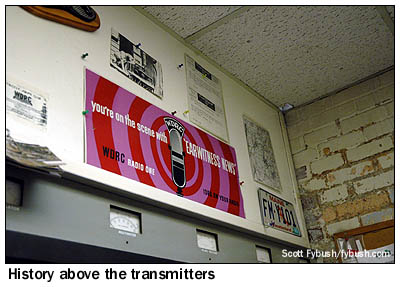
|
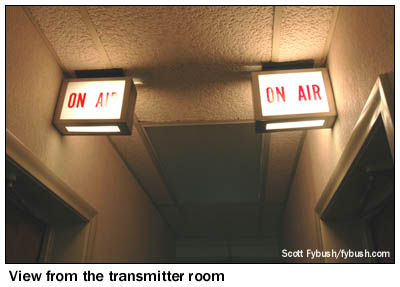
|
It's in here that we see the only visible sign of 1934 - the brick wall next to the transmitter and the window there date back to the original building, and there's some great memorabilia tacked up to the walls, including a few vestiges of the original W1XPW/W65H FM operation on which Major Armstrong himself assisted Doolittle back in the late thirties and early forties. (That station was later sold and is today's WHCN 105.9, still operating from the Doolittle/Armstrong building up on West Peak in Meriden, and we'll show you that structure in a future Site of the Week.)
The hallway that leads out of the transmitter room passes between the AM and FM studios, and they're both live and local this afternoon - to the left, Dan Lovallo's on the air with his afternoon talk show on the AM stations, while to the right, Doug Taylor's spinning the oldies - er, classic hits - on DRC-FM.
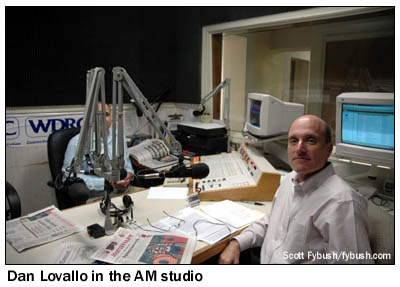
|
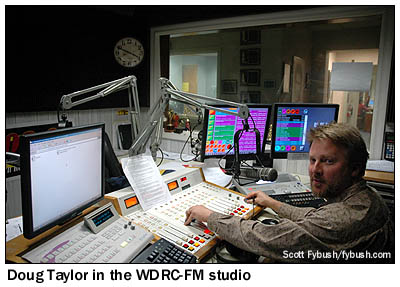
|
There's another new talk studio across the hall from the main air studios, and if you look carefully through the window in the photo below, you can see clear down to the transmitter room past the air studios. Take a left in the hallway outside, and we head down to the two production studios tucked into the 1977 addition. From there, our tour takes a big circle around the building, passing the executive offices and the main lobby, then turning back toward the new sales addition.
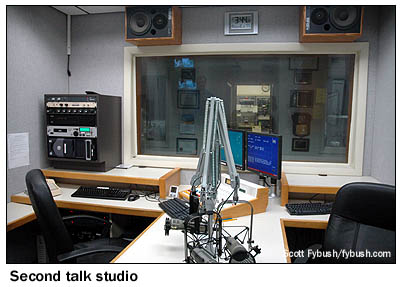
|
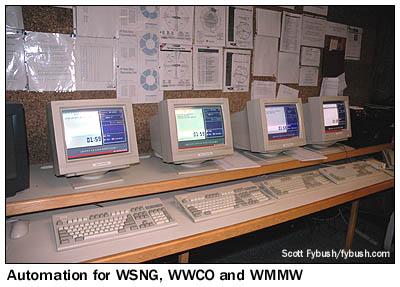
|
There's one more neat thing to see on the way there: a small room that's home to the automation systems that run the AM network. Each of the four AMs runs its own local IDs and spot breaks, even within local programming originating here, and WWCO breaks away from the network for Yankees baseball, which is run by a live board operator from a console just out of frame in the picture above.
In a world of brand-new, generic cluster studios, it's nice to see a facility with some history and personality behind it - not to mention one that's launched a ton of engineering careers in the region. Chuck Dube, now at WFCR in Amherst, spent some time here, as did John Ramsey of WCCC and Tom Ray of WOR (who still oversees the place as Buckley's corporate director of engineering). And current WDRC general manager Wayne Mulligan also rose from the engineering ranks. How often do you see that anymore?
The Tower Site Calendar 2007 is sold out! But we still have other back issues and more goodies availale at the Fybush.com Store - and check back soon for your first chance to order Tower Site Calendar 2008!
- Previous Site of the Week: Connecticut's WKND 1480 and WDZK 1550
- Next Week: WTRY, Troy, NY
- Site of the Week INDEX!
- How can you help support Site of the Week? Click here!
- Submit your suggestions for a future Site of the Week!
